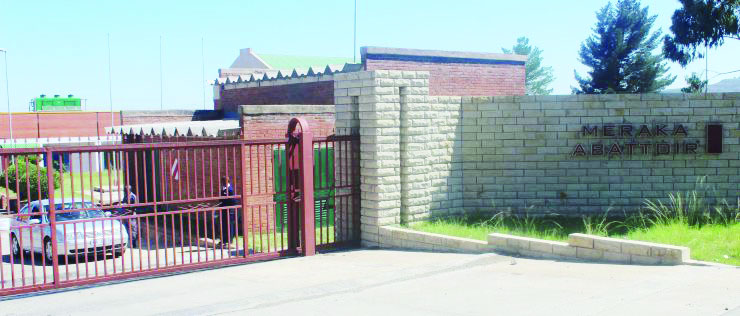Mohloai Mpesi
A study commissioned by the government has recommended for demolition of the national abattoir and be replaced with a new modern one.
But the Meat Traders Association of Lesotho (MTAL) is against this recommendation from the study conducted in May this year, and has instead suggested for the abattoir to be renovated.
MTAL argues that the abattoir is essential to the success of its members’ businesses and its protracted closure will impact negatively on these businesses.
The secretary general of MTAL, Teboho Motšephe, told Newsday this week that closing the facility will leave its customers reliant on South African operators as there is no other abattoir locally.
Motšepe mentioned that journey times to the alternative abattoirs will increase leading to an increase in the costs of doing business. These factors, he said, will force some businesses to close or limit their operations.
The National Abattoir is the only state-owned abattoir. It was established in 1983 and has a slaughtering capacity of 100 cattle or 300 sheep per day.
It is categorized as a Class-B abattoir based on several aspects such as size and quality of the cold rooms, availability of boiling water, management of the surroundings, among others.
It was closed for operation in 2003 following the government policy-decision to privatise it. In 2008, the facility was leased out to a private company (Meraka) for a duration of ten years.
Meraka abattoir is complemented by the feedlot facility, according to the National Abattoir and Feedlot Complex Inspection Report published last Friday by the Ministry of Agriculture, Food Security, and Nutrition (MAFSN).
The report further stated that the existing feedlot was dilapidated and not used efficiently. It has the average carrying capacity of more than 1200 cattle and 300 sheep at any given time.
“Currently the abattoir is closed because the private operators were complaining about the abattoir being old and obsolete. In 2022 there was a call for tenders and three companies participated and unfortunately, three of them did not meet the requirements,†read the report.
It added that: “In the light of the above, on May 29, 2023, the representatives of the MAFSN (Department of Livestock Services, Department of Marketing, Economic & Administration led by the Principal Secretary), the Economic and Development Cluster Committee members and some representatives of Meat Traders Association Lesotho toured around the National abattoir.â€
Motšephe told this publication that the abattoir had been out of operation for about four years and stressed that their businesses were suffering due to the lack of meat supply in the country.
“This affects the meat industry in the country because we do not get immediate meat supply; we have to go outside the country to buy meat, which is expensive,†he said.
He added that the continued closure of the facility would have severe economic consequences on the operation of their businesses.
The government-led inspection found that the loading pens at the abattoir are old and need to be replaced, the weighing scale is not functioning, and a new one is needed, and the stockmen’s office within the holding pens should be renovated.
“It is against abattoir standards to house the stockmen within the slaughterhouse area. The asbestos roofing should be changed as the asbestos is no longer recommended,†read the report.
It also found that water and electricity need to be reconnected, coal-powered water boilers need to be replaced using other forms of eco-friendly energy, and the abattoir conveyor rail system is old and needs to be replaced.
It was stated in the inspection report that the refrigeration system still uses ammonia which is a hazard to human health and recommended that it should be replaced.
“It is also expensive to maintain ammonia pipes because they are outdated and out of market supply. A Splitter band saw is missing or not available. The abattoir has been using the open pit to dispose of condemned meat. The office space/administration office block needs minor maintenance,†read the report.
Thabo Qhesi told Newsday this week that demolishing the abattoir was a far-sighted recommendation that should be implemented.
“Demolition of the abattoir will affect the players negatively in the short-run but having a structured facility which is compliant with international standards will be beneficial in the long-run,†Qhesi said.
“With structured facility which is compliant with international standards, there shall be positive multiplier effects in the whole ecosystem; Livestock farming, Agro-processing, wholesale, retail and Informal Sector,†he added.
He, however, acknowledged that the closure of the facility impacted meat retailers negatively.
“When the facility is not functioning, the producers (farmers) are unable to scale up their production and people resort to informal trading like Ha Matala which diminishes the value chain of our production.
“Lack of structured meat production in Lesotho has negatively affected livestock farmers because they are not able to scale up, thereby, perpetuating unemployment because job opportunities are compromised along the value chain,†he said.
He was once employed as Marketing Manager of the National Abattoir in 2000.
He said the national abattoir used to be one of the world-class facilities in Lesotho that sold to big retailers. He further suggested that it was important to have two national abattoirs to increase production.
“It is important to refurbish the current one while also building another one to increase our capacity,†he said.
The inspection report made short-term and long-term recommendations.
In the short-term, it recommended, the old operating systems of the slaughterhouse should be replaced and an incinerator to burn or manage hazardous waste should be constructed.
It also recommended that the experts from the Ministry of Works should be engaged to provide necessary support with the cost of putting buildings and structures in good or acceptable condition for tenants’ use.
“The estimated cost for upgrading of abattoir structure and equipment is M31,010,000.00 (Agri Mentor, February 2019). The main feedlot upgrading and equipment is M3,000,000.00 (Agri Mentor, February 2019),†read the report.
It also recommended visiting prominent butcheries to learn where they slaughter their animals or where they source their meat.
“We visited five facilities in total. One claimed to have a slaughter slab with rails. But he could not take us there. One slaughterhouse had basic requirements but needs some touch-ups.
“One was a slaughter slab doing horizontal slaughtering even if it was clean but needs to be upgraded to vertical slaughtering for hygienic purposes. The other one is no longer functional. It sells imported meat. The waste disposal is a challenge,†it read.
In the long-term, the report recommended, “the entire abattoir with its old and obsolete equipment should be demolishedâ€.
“If this route is pursued, the recommendations from the two feasibility studies on Red Meat Production in Lesotho by Agri Mentor, February 2019 (Commissioned by the Government of Lesotho – Economic Diversification Support Project) and Global Engineering (March 2020) commissioned by the Government of Lesotho – Ministry of Agriculture and Food Security, respectively, should be implemented with adjustments where necessary,†it read.




